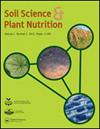利用水-糙米转移参数和137Cs/133Cs比值估算水源137Cs在糙米总137Cs中的贡献
IF 1.8
4区 农林科学
Q3 ENVIRONMENTAL SCIENCES
引用次数: 1
摘要
摘要:本研究的目的是估计水源性137Cs对福岛南相马糙米中137Cs总活性的贡献。3种估算方法分别是:1)水-糙米137Cs浓度比(CR-water-rice), 2)水-糙米137Cs总活性质量平衡比(MB-water-rice), 3) 137Cs/133Cs比值。为了获得水到糙米的转移参数(CR-water-rice和MB-water-rice),水稻植株生长在装满福岛南相马(Minamisoma)土壤的盆栽中,并用三种类型的水(含0.39 mg L−1 K+的不含137Cs的自来水、含1.0 mg L−1 K+的不含137Cs的自来水和含5.6 Bq L−1 137Cs和1.0 mg L−1 K+的自来水)灌溉。在福岛南相马市的灌溉水、土壤和糙米中,137Cs的活性浓度分别为0.032 Bq L−1、1.04和0.0012 Bq g−1干wt。根据CR-water-rice参数估算,糙米中的水源137Cs仅占1.9%。如果用MB-water-rice参数估计,则为2.8%。糙米中137Cs/133Cs的比值为0.00162 Bq ng−1,与土壤可交换部分的比值(0.00173±0.00007 Bq ng−1,n = 3)相似,因此,灌溉水中137Cs对糙米的贡献可以忽略不计。三种不同方法估计的结果一致。因此,这些方法将成为评估水源性137Cs在福岛南相马糙米137Cs总活性中的贡献的有用工具。137Cs/133Cs比值估算方法也适用于其他地区的水稻。本文章由计算机程序翻译,如有差异,请以英文原文为准。
Estimate the contribution of water-derived 137Cs in the total 137Cs in brown rice using water-to-brown rice transfer parameters and the ratio of 137Cs/133Cs
ABSTRACT The purpose of this study is to estimate the contribution of water-derived 137Cs in the total activity of 137Cs in brown rice collected from Minamisoma, Fukushima. Three different methods used for the estimation were: 1) the concentration ratio of 137Cs from water to brown rice (CR–water–rice), 2) mass balance ratio of the total activity of 137Cs from water to brown rice (MB–water–rice), and 3) the ratio of 137Cs/133Cs. To obtain water-to-brown rice transfer parameters (CR–water–rice and MB–water–rice), rice plants were grown in pots filled with soil collected from Minamisoma, Fukushima and irrigated with three types of water (tap water free of 137Cs containing 0.39 mg L−1 K+, tap water free of 137Cs containing 1.0 mg L−1 K+, and tap water containing 5.6 Bq L−1 137Cs and 1.0 mg L−1 K+). The activity concentrations of 137Cs in irrigation water, soils, and brown rice collected from Minamisoma, Fukushima were 0.032 Bq L−1, 1.04, and 0.0012 Bq g−1 dry wt, respectively. Water-derived 137Cs in brown rice only accounted for 1.9% estimated from the CR–water–rice parameter. It was 2.8% if estimated with the MB–water–rice parameter. The ratio of 137Cs/133Cs in brown rice was 0.00162 Bq ng−1, similar to that in the exchangeable fraction of soils (0.00173 ± 0.00007 Bq ng−1, n = 3). Thus, the contribution of 137Cs from irrigation water to brown rice was negligible. The results estimated by three different methods were in good agreement. Therefore, these methods will be useful tools for assessing the contribution of water-derived 137Cs in the total activity of 137Cs in brown rice collected from Minamisoma, Fukushima. The estimation using 137Cs/133Cs ratio can also be applicable for rice in other regions.
求助全文
通过发布文献求助,成功后即可免费获取论文全文。
去求助
来源期刊

Soil Science and Plant Nutrition
农林科学-农艺学
CiteScore
4.80
自引率
15.00%
发文量
56
审稿时长
18-36 weeks
期刊介绍:
Soil Science and Plant Nutrition is the official English journal of the Japanese Society of Soil Science and Plant Nutrition (JSSSPN), and publishes original research and reviews in soil physics, chemistry and mineralogy; soil biology; plant nutrition; soil genesis, classification and survey; soil fertility; fertilizers and soil amendments; environment; socio cultural soil science. The Journal publishes full length papers, short papers, and reviews.
 求助内容:
求助内容: 应助结果提醒方式:
应助结果提醒方式:


